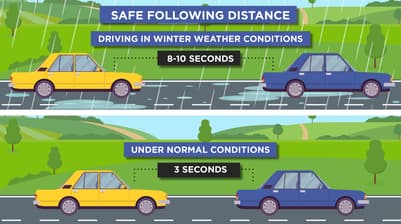Driving in adverse weather conditions
Weather conditions in the UK have become so changeable over the last few years from blistering heat to biblical downpours to thick snow, we’ve had it all! As we adapt to these extreme weather conditions so should our driving styles to navigate the roads as safely as possible. Here is a quick guide to help you adapt you’re driving to suit the circumstances:
Wet weather
When braking in wet weather your car’s stopping distances can be double what they would be on dry roads as the tyres will have less grip with all the surface water between the tyre and the road. If the tyres aren’t gripping the road properly you may notice that the steering is unresponsive, this is known as aquaplaning. If this happens you need to gradually slow down easing off the accelerator as you go.

To keep yourself and other motorists safe you should keep plenty of distance between you and the vehicle in front. Often visibility is reduced from the surface spray from the road even if the rain has stopped, so extra precautions should be taken when driving in wet weather.
Icy and snowy weather
It is advisable where possible to avoid driving in ice and snow unless it is for essential travel. Should you need to, make sure you allow extra time for the journey. Before setting off ensure you have good visibility, clear any snow or ice from your windows and de-mist all the mirrors and windows thoroughly. It is vital that you are visible to other motorists too so ensure the lights are working, they’ve been cleaned and cleared of snow and ice and the number plates are clearly visible. Clean off any snow from your car roof that could fall into the road when you are driving. Before setting off, ensure you check the pressure of your tyres and the tyre tread depths to help improve grip on wet roads. If possible, consider replacing your tyres with All-season tyres which adapt to the varying weather conditions.
In case you get stranded or your car breaks down it is recommended that motorists carry a torch, de-icer and an ice scraper, a first aid kit, some warm clothing and boots, a shovel and a set of jump leads. You may also consider packing a warm drink and some food.
Once you have set off, it is vital you drive with care keeping a good distance back from the car in front. Drive at low speeds, breaking very gently. If the road is icy try driving slowly in a high gear. Avoid making any sudden manoeuvres, even roads that have been treated with salt or de-icing products can be treacherous.
Windy weather
Strong gusts of wind can blow even the most experienced drivers off course. Care must be taken when travelling in high winds especially if you are driving at high speeds near high-sided vehicles and motorcycles.
Fog
Fog seemingly just appears from nowhere and suddenly visibility is very poor. When driving through the fog ensure you slow down, use your lights and stay well back from the vehicle in front. If necessary, use your de-misters and windscreen wipers to clear your vision. Be aware of your surroundings and other road users, especially those who are not using their lights. Always check your mirrors and be alert. If visibility is particularly poor then put your fog lights on, be mindful though that these can dazzle oncoming drivers so only use them when necessary.
Hot weather
Steering and braking are the main areas that can be affected by hot weather conditions as the road surface softens in the heat. Rain following a hot spell can lead to slippery surfaces. Bright sunshine can cause visibility issues, so slow down and take care when driving.
Did you enjoy this blog post? |10 people found this review helpful



